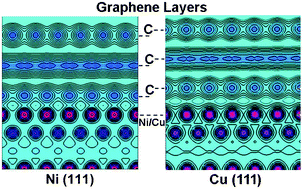| Mike's Pages |
Links |
Graphene layers on Cu and Ni (111) surfaces in layer controlled graphene growth
Qiang Wang, Li Wei, Michael Sullivan, Shuo-Wang Yang, Yuan Chen
School of Chemical and Biomedical Engineering, Nanyang Technological University, 62 Nanyang Drive, Singapore, Singapore 637459, Institute of High Performance Computing, 1 Fusionopolis Way, 16-16 Connexis, Singapore, Singapore 138632, Department of Applied Chemistry, College of Science, Nanjing University of Technology, Nanjing 210009, P. R. China
Received 29 Nov 2012, Accepted 20 Dec 2012 First published online 20 Dec 2012
RSC Advances, 2013, 3, 3046-3053.

ABSTRACT:
The properties of graphene strongly depend on its thickness. It is important to understand the graphene-metal interaction to control its thickness during its growth on metal surfaces. Here, we used the DFT-D2 method of Grimme, which includes the critical long-range van der Waals forces in the graphene-metal interaction, to study the interfaces between mono-, bi-, and trilayer graphene and Cu and Ni (111) surfaces. Our results show the adsorption energy increases with the increase of graphene layers on Ni (111); in contrast, it decreases on Cu (111). Charge density and partial density of states analyses show that monolayer graphene adsorbed on Ni (111) is more reactive than that on Cu (111). Another graphene layer can be easily formed on top of monolayer or bilayer graphene adsorbed on Ni (111); but not on Cu (111). These findings provide a useful guide for achieving precise layer controlled graphene growth and designing graphene based devices.
DOI: 10.1039/C2RA23105K